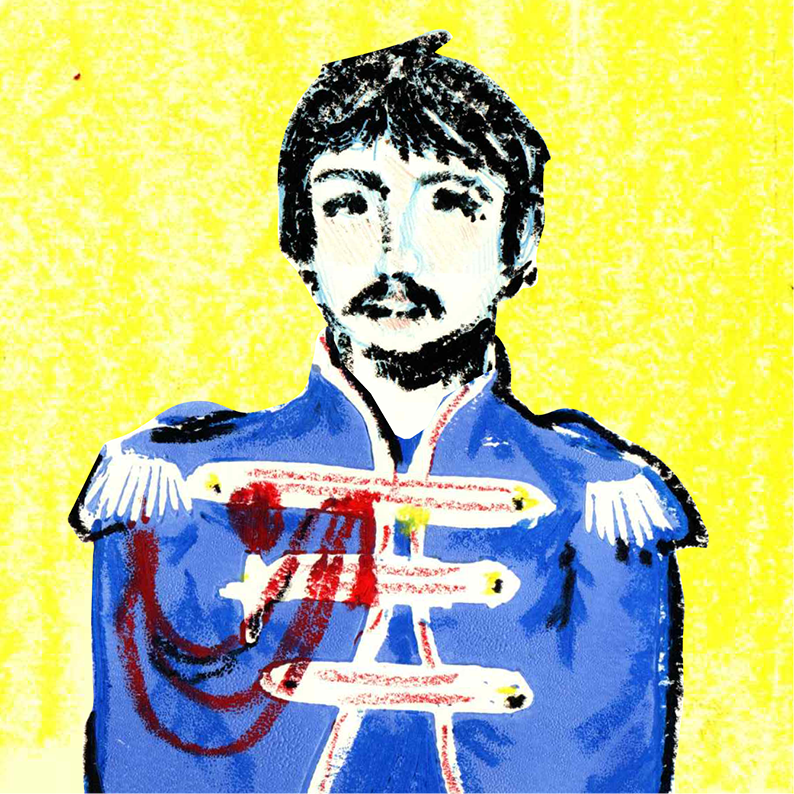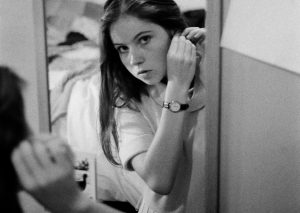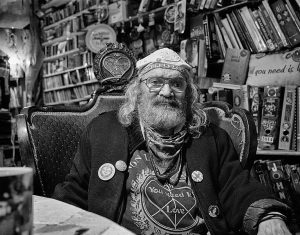
The Act You’ve Known for All These Years
by Mia Walby | June 28, 2023
“John Lennon came into the NME [New Musical Express] to see me in disguise. He’d got a false beard and he was dressed in the most ragged clothes you’ve ever seen. He said, ‘I don’t want to be recognised by anybody. Let’s go and have a cup of tea.’ We went to Julie’s and sat talking about the concert. After a while another café door opened and another altogether disreputable figure with ragged trousers, a beard and lanky, dirty hair shambled up to the counter to pick up a cup of tea. As he passed our table he said, ‘Hello, John,’ and John said, ‘Hello, George.’” — Derek Johnson, music journalist.
In the early sixties, before The Beatles’ harmonised “yeah, yeah, yeahs” dominated the charts, their fame and success was still a dubious dream. Slumped in the drab dressing rooms of subpar venues, the band frequently had the dour spirits to match. To pierce their pessimism, John Lennon would forsake his familiar nasal drawl and adopt an American twang. Infusing his voice with pep, Lennon would exclaim to his moping bandmates: “Where are we goin’ fellas?”
“To the top Johnny!” they would reply in unison, revitalised.
“And where’s that fellas?”
“To the toppermost of the poppermost!” Came the proclamation, in what would become an early mantra for the band.
“Riiiight!”
It was self-fulfilling. But the stratospheric ‘toppermost’ Lennon, McCartney, Harrison, and Starr were to ascend to was an unprecedented, dizzying height. And in rising so high so swiftly, it might seem inevitable that they would suffer from motion sickness. In 1966, there was an increasing sense of vertigo after a year populated with problems. Following a hellish American tour, shaken by hostility after tour dates in the Philippines, and dealing with prolonged, incensed backlash after Lennon’s comment that the band was “more popular than Jesus,” they decided to quit touring. The Beatles were tired of being The Beatles.
The band was three years deep into the fanaticism of Beatlemania. Once the roars of approval began, they showed little sign of stopping. The world smothered McCartney, Lennon, Harrison, and Starr with praise, deafening them with unrelenting screams and shouts – even at their homes, swathes of fans assembled to stand sentinel before their driveways. In their ambition to reach the ‘toppermost,’ The Beatles had not stopped to consider what it might be like there, secluded in the realm of clouds and gods, where everyone can see you but few can know you. “I asked to be successful,” Harrison reflected to journalist Maureen Cleave that year. “I never asked to be famous. I can tell you I got more famous than I wanted to be.” Hunter Davies, in the band’s authorised biography, succinctly encapsulates their predicament: “Being rich and powerful and famous enough to open any door was pointless. They were trapped.” Having climbed too high, they could not come down, and they were soon mired in a goldfish bowl they had long outgrown.
The band was initially willing to smile through the bars of their confinement. They had a mythology to maintain as the Fab Four: a mop-topped brotherhood, which they were going to sugar-coat, lie, and fabricate to keep going. In 1963, Harrison mildly told reporters, “We don’t have a private life anymore…we’re public property now. Not that we mind…you get accustomed to it.” Though they no longer belonged to themselves, to keep the mythology alive they had to be reduced to images for consumption, garnished for a greedy public. The characteristic epithets attached to them by the press are revealing in how, while they were clamoured after, only flattened versions of the band members were coveted. George was the quiet one, John the witty one, Paul the cute one – Ringo the other one. Michael Braun, who chronicled the beginning of the band’s rise in 1963, described the popular British perception of them as “four local lads with funny but acceptable haircuts,” labelling them “clean, adorable, cheeky.” It is a surprisingly costly burden to be fragmented to a hairdo, cheeriness, and cheekiness. So, by 1966 all four Beatles were hankering to escape the stereotypes that had come to define them, the Fab Four-ness of it all. To break away, they needed to make a new fiction.
Artists inventing their identities was nothing new in the sixties. Before Bob Dylan was Bob Dylan, he was Robert Zimmerman, a suburban storekeeper’s son from Minnesota. When he arrived in New York in 1961, he was in the process of embroidering an elaborate fictitious backstory for himself. Later that year, a 20-year-old Dylan was interviewed by Oscar Brand on WNYC’s Folksong Festival. There, he nonchalantly told Brand he was raised in Gallup, New Mexico, before spending his adolescence travelling with a carnival. “He told his friends in the coffeehouses back in Minnesota that what he had to do to be a star is create a character that sells,” Dylan biographer Dennis McDougal notes. “And that is precisely what he set out to do. When you create a character that sells […] if you embellish just a little […] people’s ears perk up and pay attention.” It didn’t matter if none of his assertions were true or even half-true, Dylan was weaving his own mythology and using it to forge his way to fame. But while Dylan assembled his lies to propel his legend, The Beatles were fabricating alter egos to shirk themselves of the mythos they had unwittingly built. Enter 1967’s Sgt. Pepper’s Lonely Hearts Club Band.
Now regarded as an early concept album, the idea was that the music would be made by The Beatles, but it would not beThe Beatles. Rather, it would be a performance by the fictional Sgt. Pepper band. McCartney disclosed that a central desire behind this decision was to divorce from their Fab Four personas:
“We were fed up with being The Beatles. We really hated that fucking four little mop-top boys approach. We were not boys, we were men. It was all gone, all that boy shit, all that screaming, we didn’t want any more, plus, we’d now got turned on to pot and thought of ourselves as artists rather than just performers.”
While on their 1966 tour, the band could scarcely hear themselves play above the screaming fervour of fans – now, they wanted their music to be listened to and appreciated. They were going to be artists: creating, inventing, innovating. Elsewhere, less scathingly, McCartney declared “I thought it would be nice to lose our identities, to submerge ourselves in the persona of a fake group. We could make up all the culture around it and collect all our heroes in one place.” Central to the endeavour was the desire to myth-make, to construct a culture around themselves, to self-fashion. “Nothing happened in the ‘60s except that we all dressed up,” Lennon later reflected, but clearly for the band ‘dressing up’ was about more than just putting on a costume.
When one tires of being a Beatle, become a Beatle pretending to be someone else – it would be just as real as the flimsy, one-dimensional images of themselves already ricocheting around. This distance from the Beatle image leant space for the band to toe a creative fantasy, to experiment musically and, also, under the masks of alter egos, toy with notions of authenticity. As the Sgts., they question the nature of identity: what is the difference between a costume you adorn and the real thing? By fashioning yourself into a deliberately inauthentic version, you may be erecting an identity that is false, but at least it’s of your own making. In the album’s titular opening track, McCartney bellows, “So may I introduce to you/ The act you’ve known for all these years/ Sgt. Pepper’s Lonely Hearts Club Band.” The chorus soon implores us to “enjoy the show.” Music historian Kenneth Womack argues that these lyrics “mock the very notion of a pop album’s capacity for engendering authentic interconnection between artist and audience.”The Beatles may have still been content to put on a show, but they crucially draw attention to the one-sided nature of the intense relationship their fans believed themselves to have formed. The light-hearted lyrics expose that the public know The Beatles no more than they know this fictional band. It was all a show, mere performance at play.
The album’s cover is emblematic of the performance within. The Beatles, costumed in psychedelic Edwardian military attire, pose on a bandstand. A crowd of their heroes surround them in cardboard and waxwork form, among them Edgar Allan Poe, Bob Dylan, Marilyn Monroe, and Karl Marx. To Lennon’s right, on loan from Madame Tussauds, stand the wax models of the band in their Beatlemania-era, polished and genial in matching suits. We are invited to regard the wax Beatles as no more fake than their Sgt. counterparts. As Lennon, McCartney, Harrison, and Starr pose among the cardboard and the wax, the cover compels us to consider the ‘show’ of it all: who do you want to be? Who are you pretending to be?
As The Beatles croon “we hope you have enjoyed the show” on the final track of the album, it is clear how fleeting this performance has been. When you are The Beatles, you cannot cease being The Beatles for long – the Sgt. charade lasts for just the time it takes for the needle to spin around the record. You can briefly put on a costume and play pretend as Sgt. Pepper’s Lonely Hearts Club Band, but ‘The Beatles’ of it all will trail behind and must soon be resumed. While the critical and commercial success of the album allowed the band to shed themselves of their Fab Four personas, it also meant that the legend of The Beatles was propagated exponentially. It was the bestselling album of the entire decade in the UK. And so, at the ‘toppermost’ they were to remain.
In a 1980 interview for MUSICIAN: Player & Listener Magazine, McCartney frankly discusses fame’s thorns: “At first you’re just an ordinary Joe, knocking around trying to make a living. Then you get famous, you get your first hit. And people ask for your autograph, and you love it. There’s nothing you want more than to do any amount of autographs – you want them, I’ll do them…that kind of wears off after about three or four years.” In early 1963, when their success still seemed like it could be an ephemeral thing, McCartney habitually signed autographs as “Paul McCartney (The Beatles)”. Later, he may have stopped signing “The Beatles” in parenthesis, but that was because by then it went without saying. The inextricability of the Beatle moniker to their public identities was cemented, whether scrawled down or not. While as an artist you may be a human being with tastes and talents and relationships, your image has a life of its own. It is this public image which is evoked and related to, which threatens to devour the real thing and leave just the husk.
Trying to know The Beatles and dissect their mythology is the cultural scab we cannot seem to stop picking at. Between 1978 and 2010, seven biopics attempted to tell the story of The Beatles in one form or another. More recently, 2019’s Yesterday hypothesised the cultural implications of the band never existing. However, Peter Jackson’s 7 hour 48 minute long 2021 documentary Get Back is perhaps the most successful attempt at portraying the band, not just as the mythic Beatles, but as Paul, John, George, and Ringo. Charting 21 days in the studio with the band as they rehearsed for their forthcoming album Let It Be and their infamous rooftop concert, it is peppered with the band’s ordinary moments – with bald humanity. Jackson tells the story of four musicians outgrowing their identity as a band and figuring out who they now are to each other and to themselves. It undresses the band, laying them bare before us. It is just that we regardless remain consumed by the myth which often threatens to render the reality obsolete.
“Things only get bad when people forget you’re a human being,” McCartney said in 1994. That year someone gifted McCartney a Beatles trivia game where the first question he read was “What did Paul McCartney’s mother die of ?” As a Beatle, people were prone to forget you were, or at least once were, human. Over a decade after the band’s split, Harrison once pointedly remarked: “They’re not interested in me as a human being; they’re only interested in The Beatles…I’m not The Beatles.” But how you wish to be perceived is rarely the reality, regardless of your attempts to shape it. Over fifty-five years after Sgt. Pepper’s release, it would seem The Beatles will be fated to be known forever as The Beatles – even aged, even dead, even all dressed up.
∎
Words by Mia Walby. Art by Louis Rush




